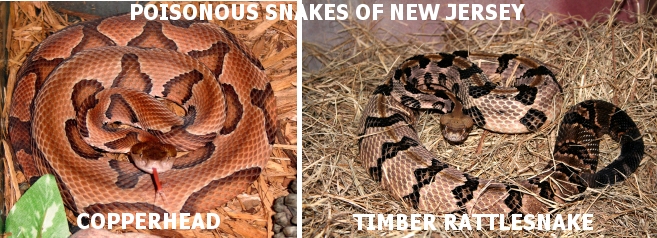Poisonous Snakes of New Jersey
 Poisonous Snakes: Northern Copperhead and the Timber Rattlesnake |
Copperhead Agkistrodon contortrix (24-36", up to 53")
The copperhead is a venomous snake with a broad triangular head, vertically
elliptical pupils and a heat sensitive pit between each eye and nostril.
The body is pinkish to grayish brown with brown or reddish-brown crossbands
that are narrow on the back and widest on the sides. Small dark spots
commonly occur between crossbands on the back. The unpatterned head
is dull orange, copper or rusty-red. Body scales are keeled
and the belly is pink or light brown with dark blotches along the sides. When young, a copperhead
has a yellow-tipped tail.
Mating takes place in spring and fall and females give birth to 4-8 young in August and September. Adult females usually give birth every two years.
Copperheads prefer rocky, forested hillsides and wetlands for habitat. Wet areas are particularly sought out in the hot summer months. Small mammals and frogs account for most of the prey items taken, but birds, insects and other snakes are also important parts of their diets. When approached, they will either move away quietly or lay motionless, relying on camouflage to protect them. Occasionally, they will vibrate their tails. Bites usually occur when people unknowingly step on or touch unseen snakes. Despite the venomous nature of copperhead bites, they are rarely fatal. In New Jersey, copperheads are so rare and reclusive that people almost never encounter them.
Timber Rattlesnake (Crotalus horridus)
Description
The timber rattlesnake is a heavy-bodied snake with a broad head that is distinct from its narrow neck. The top of the head is unmarked and usually yellow to light gold in color. Adult timber rattlers average 35 to 50 inches in total length. They have a yellow, brown, rust-orange, or in rare cases gray ground color with black or dark brown crossbands extending along the back. There is a dark brown stripe behind each eye, and there may be a rust-colored middorsal stripe from the neck to the tail. The tail is short and thick, all black, and tipped with a tan rattle. Juvenile timber rattlers are marked like the adults.
Distribution
This species occurs from southern New Hampshire and southern Ontario to northern Georgia, and west to southeastern Minnesota through northeastern Texas. In New Jersey they are generally found in the north-western area of the state or in the pine barrens.
The range of this species has changed little since historical times. However, within their current range, their distribution has become very patchy and fragmented. In fact, this species is considered rare to imperiled in fifteen and in Ontario, and is extirpated from two states.
Habitat
Timber rattlesnakes can typically be found in bluff prairies and oak woodlands in relatively remote areas. They prefer rocky outcrops and open grassy areas with southerly exposures in the spring and fall. During the summer, they inhabit deciduous forests and open valleys. Rock fissures and crevices provide communal dens for overwintering
Timber rattlesnakes are not a major threat to humans and livestock. This snake has a secretive nature and prefers those areas that are mostly unused by humans. Timber rattlers prefer to remain quiet, relying on their cryptic coloration to go unnoticed. They often are reluctant to rattle, preferring not to call attention to themselves. This rattlesnake is notably docile unless provoked or unless going through a molting cycle, which impairs their vision. They can be defensive if disturbed and will bite.
| Middlesex County | Monmouth County | Somerset County | Union County | Warren County |
and Richmond County (Staten Island), NY